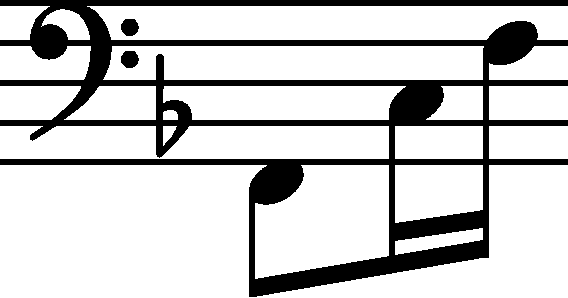



The extensive crossings-out in A – the entire ending of the piece starting from b. 19 was eventually crossed out and had to be rewritten – reveal that Chopin was looking for the best way to transfer the figuration from the topmost register back to the middle range of the instrument.
- Bar 19 was a transposition of b. 11 (an octave higher).
- Bar 20 was a counterpart of b. 19 of the final version – the R.H. part was exactly the same, and in the L.H. part Chopin probably wrote the following text:
 . The notation bears traces of local corrections performed before the entire ending was crossed out, hence it seems impossible to decipher all elements of notation, not to mention determining the order of versions, without specialised studies (e.g. one can see an even earlier – crossed out separately – notation of the beginning of the 2nd half of the bar
. The notation bears traces of local corrections performed before the entire ending was crossed out, hence it seems impossible to decipher all elements of notation, not to mention determining the order of versions, without specialised studies (e.g. one can see an even earlier – crossed out separately – notation of the beginning of the 2nd half of the bar  ).
). - In the middle of b. 20, discussed above, one can see a crossed-out bar line, which is followed by a half of a bar compliant with one of the halves of b. 20 of the final version. Therefore, Chopin may have initially miscalculated the length of the ending, which also significantly contributed to the decision about the need to rewrite the entire ending.
- The final 2 bars (21-22) were being changed only in the L.H. part. The earlier version is presented below:
 . On the 1st beat of b. 21 one can see traces of corrections suggesting that, e.g. the initial F note was a semiquaver. Chopin then crossed out the entire notation of that bar and rewrote it on a stave below in the final version. However, the latter was also crossed out, since the accumulation of corrections and excess of bars forced the composer to rewrite b. 19-22.
. On the 1st beat of b. 21 one can see traces of corrections suggesting that, e.g. the initial F note was a semiquaver. Chopin then crossed out the entire notation of that bar and rewrote it on a stave below in the final version. However, the latter was also crossed out, since the accumulation of corrections and excess of bars forced the composer to rewrite b. 19-22.
Compare the passage in the sources »
category imprint: Corrections & alterations; Source & stylistic information
issues: Corrections in A, Deletions in A, Accompaniment changes, Main-line changes
notation: Pitch
